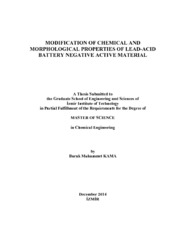Please use this identifier to cite or link to this item:
https://hdl.handle.net/11147/4315| Title: | Modification of Chemical and Morphological Properties of Lead-Acid Battery Negative Active Material | Other Titles: | Kurşun Asit Akü Negatif Aktif Malzemesinin Kimyasal ve Morfolojik Özelliklerinin Modifikasyonu | Authors: | Kama, Burak Muhammet | Advisors: | Polat, Mehmet | Keywords: | Lead-acid batteries | Publisher: | Izmir Institute of Technology | Source: | Kama, B. M. (2014). Modification of chemical and morphological properties of lead-acid battery negative active material. Unpublished master's thesis, Izmir Institute of Technology, Izmir, Turkey | Abstract: | Lead-acid batteries which are indispensable equipment for motor vehicles are one of the most important electrochemical processes commercially thanks to their advantages, such as low cost and capability of providing high energy. The new generation cars which such as climates, smart screens, stronger engines etc., require the batteries which should have longer cycle life and higher cold-cranking ampere. In this study, the aims were elucidating the exact working mechanism of lead-acid battery negative active material and improving the commercial lead-acid battery for micro-hybrid vehicles. For this purpose, experimental studies were separated to three parts. First one is the characterizing of negative electrode raw materials, leady oxide, lignosulfonate, carbon, barium sulfate. Second one is determination of rheological properties of negative paste in different cases. Third one is the preparation of pastes and then performance testes (reserve capacity, cold-cranking ampere and cycle life) of negative plates prepared from the pastes characterized in second part. As a result of first part of studies, it was shown that the all of carbon materials and leady oxide suffer from agglomeration in lignosulfonate solutions prepared in different concentrations. In second part, the rheological properties of negative paste were determined in different preparation cases and shown that the amount of additives and preparation method has big effects. Finally, the negative plates were prepared with two methods, wet and dry mixing. After that the plates were formed and then electrical tests were performed. Consequently, a battery which has better properties, physically and chemically, was obtained. However, this improvement was not enough due to the dispersion problems of carbon samples tested in this study. | Description: | Thesis (Master)--Izmir Institute of Technology, Chemical Engineering, Izmir, 2014 Full text release delayed at author's request until 2018.01.15 Includes bibliographical references (leaves: 72-76) Text in English; Abstract: Turkish and English xi, 76 leaves |
URI: | http://hdl.handle.net/11147/4315 |
| Appears in Collections: | Master Degree / Yüksek Lisans Tezleri |
Files in This Item:
| File | Description | Size | Format | |
|---|---|---|---|---|
| T001321.pdf | MasterThesis | 4.91 MB | Adobe PDF |  View/Open |
CORE Recommender
Page view(s)
252
checked on Dec 30, 2024
Download(s)
654
checked on Dec 30, 2024
Google ScholarTM
Check
Items in GCRIS Repository are protected by copyright, with all rights reserved, unless otherwise indicated.